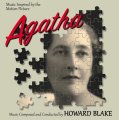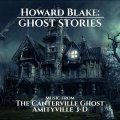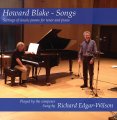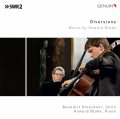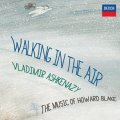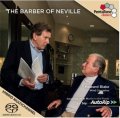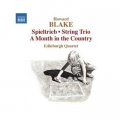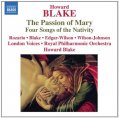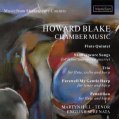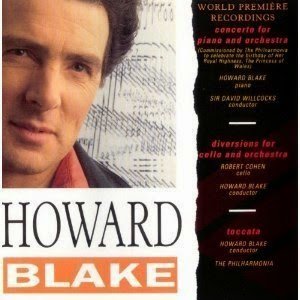 Highbridge Music Ltd.
Highbridge Music Ltd.
Studio 6, 18 Kensington Court Place, London W8 5BJ, UK
Email: howard@howardblake.com
*PIANO CONCERTO op.412 (April 1991)
A concerto for piano and orchestra in three movements
Published by: Highbridge Music LtdCommissioned by: Rodney Stewart as chairman of The Philharmonia Orchestra, with assistance from The Arts Council of Great Britain
Instrumentation: 2(II=picc).2.2.2 - 4.2.trbn.btrbn.0-timp-perc(1):glsp/xyl/SD/susp.cym/cyms/tgl - strings
[Key to Abbreviations]
Duration: 26 mins
First Performance: The concerto for piano and orchestra was commissioned by The Philharmonia orchestra to celebrate the 30th birthday of their President, HRH Diana, Princess of Wales. It was given its premiere performance in her presence on June 19th 1991, shortly before her thirtieth birthday, at The Royal Festival Hall, played by Howard Blake, solo piano, and The Philharmonia Orchestra conducted by Carl Davis.
Sheet Music Available
Instrumental / piano score for saleFull score for hire
Study score for hire
Orchestral parts for hire
Two-piano score available for rehearsal
Recordings Available
Concerto for piano and orchestra; Diversions for cello and orchestra; Toccata
Recorded: 1991
Artists: Howard Blake (piano), Sir David Willcocks (conductor); Robert Cohen (cello); Howard Blake (conductor); The Philharmonia
Recorded: 1991
Artists: Howard Blake (piano), Sir David Willcocks (conductor); Robert Cohen (cello); Howard Blake (conductor); The Philharmonia
1. CD COLOMBIA/SONY CLASSICS CD ORIGINALLY RELEASED IN MAY 1991: HOWARD BLAKE (PIANO), THE PHILHARMONIA ORCHESTRA CONDUCTED BY SIR DAVID WILLCOCKS SONY HB3 23
2. SONY CLASSICS: RE-RELEASE OF THE ORIGINAL ALBUM (AS ABOVE) ON OCTOBER 28TH 2008 WITH NEW BOOKLET AND ARTWORK (COPYRIGHT SONY BMG MUSIC ENTERTAINMENT (UK LTD) 869737697
2. SONY CLASSICS: RE-RELEASE OF THE ORIGINAL ALBUM (AS ABOVE) ON OCTOBER 28TH 2008 WITH NEW BOOKLET AND ARTWORK (COPYRIGHT SONY BMG MUSIC ENTERTAINMENT (UK LTD) 869737697
Movements
-
1:
Tranquillo - Allegro con brio
12 minutes
28 seconds
-
2:
Andante Espressivo
6 minutes
54 seconds
-
3:
Vivace
6 minutes
30 seconds
Notes
Reviewed in the United Kingdom on 16 September 2015Performances
| 31st January 2020 | Julian Trevelyan with the Ealing Symphony Orchestra conducted by John Gibbons in a seasonal programme including The Snowman, Assembly Hall Worthing |
| 31st January 2020 | Julian Trevelyan solo piano, John Gibbons conductor, Worthing Symphony Orchestra,'The Snowman' narrated by Howard Blake7.30pm, Assembly Hall, Worthing, Sussex
See worthing theatres website: www.worthingtheatres.co.uk phone 01903 206 206
Julian will give his second performance of the Howard Blake Piano Concerto in a popular seasonal concert which will also feature the concert version of 'The Snowman', Tchaikovsky Swan Lake Waltz, Delius Sleigh Ride, Sibelius Karelia Suite, Rimsky Kosakov Dance of the tumblers, Leroy Anderson 'Sleigh Ride' and Waldteufel Skaters Waltz. |
| 31st January 2020 | Julian Trevelyan piano, John Gibbons conductor, Howard Blake narrator, Worthing Symphony Orchestra "Walking In The Air" concert at Assembly Hall, Friday 31 January 2020 (7.30pm)
Worthing Symphony Orchestra “Walking In The Air” concert - reviewREVIEW BY Richard Amey Thursday, 6th February 2020, 11:15 am Updated Thursday, 6th February 2020, 11:17 amWSO Conductor John Gibbons Worthing Symphony Orchestra “Walking In The Air” concert at Assembly Hall, Friday 31 January 2020 (7.30pm), composer Howard Blake (narrator), John Alley (piano), Victoria Ridgway (singer) John Gibbons BEM (conductor), Julian Trevelyan (concerto piano). Nik Rimsky-Korsakov, Dance of The Tumblers (from The Snow Maiden); Fred Delius, Sleigh Ride; Emil Waldteufel, Skaters Waltz; Howie Blake, The Snowman, concert version; Pete Tchaikovsky, Waltz (from Swan Lake); Leroy Anderson, Sleigh Ride; Johnny Sibelius, March (from Karelia Suite); Howie Blake (again), Piano Concerto Op142 (/650+). It was as though Sergei Prokofiev had been right there, narrating his own Peter And The Wolf with Worthing Symphony Orchestra. To audience surprise, Howard Blake was doing the same in The Snowman – a children’s composition of parallel universal success composed by he, an ex-Brighton & Hove Grammar School boy, and with some primary and secondary classmates in the audience. Unbilled except last-minute on social media, Blake told me he was narrating a Snowman concert performance for the first time in five years. He was standing in for also-unpublicised actor Bernard Cribbins OBE, whose wife was unwell. Wombles voice-over Cribbins reached 91 in December. A month earlier, Blake OBE made it to 81, although he scarcely moves or looks older than 70. That’s the therapy of music for you. Blake’s own ‘local lad makes good’ story happened 40 years ago when his idea of a TV cartoon outlawing dialogue struck gold. Instead, it’s musically with descriptive richness and synchronised with the precision of a Tchaikovsky-Petipa ballet, and delivering a hit song that seasonally sits alongside Irving Berlin’s White Christmas. The familiar I’m Walking In The Air – the only words heard in the cartoon film – is sung by the Boy when the Snowman he has built suddenly lifts him up into flight, out over Brighton and up to the North Pole for a knees-up at a snowmen’s party visited by Father Christmas. A thaw-surviving scarf from that is living proof it happened for real, trumping at Christmas the Nutcracker Doll that can only underline a dream. Now it was happening right here, without the images but with author Raymond Briggs’ dialogue pointed up by Blake’s music. A different and rewarding audience experience this way round. And a master class in light film music orchestration . . . Sleep? Harp or strings. Fun building a snowman? Fairy harp and chirpy flute. Snowman greets his young creator? Cheery piccolo. Atmosphere around the boy’s house? Sober, nostalgic oboe. Terrified fleeing cat? Screeching strings. Snowman curious about human life? Cheeky bassoon or avuncular horn. Perilous sources of heat? Cymbals! (Furtive footsteps? Xylophone) Music box? Glittery harp, piano, flute, piccolo. Motor-bike escapade? Tearing orchestra with xylophone saddled on top! The Celidh of the Father Christmases? Celtic pub dance tunes on flutes, piccolo, xylophone, muted trumpet. And binding much together, the piano – setting new scenes, initiating rhythm and texture, creating mystery, punctuating or decorating percussively, bringing sentiment and affection, opening the mood and flow of I’m Walking In The Air for vocalist Victoria Ridgway – from Crawley, invited from the West Sussex Youth Choir. The 17-year-old was singing it publicly for the first time and her nerves in the opening verse counted in her artistic favour. Initially frayed-edged in childlike wonder and fear (“What? My snowman’s really a bird?”), her voice gained in confidence (“He’s not going to drop me now – I’m flying too!”) arriving at a purity (“This is the best adventure I’ve EVER had”). Incidentally, the washes of cymbals evoked for me the Cornish beach hut where Blake, years before, first thought of this tune. Blake’s is an unfamiliar face to most. His narration was thus like listening to a story a nice granddad at a small (under-control) children’s birthday party up the road. Throughout The Snowman, I sensed the audience’s adults captured by their own fascination and progressively moved. The final ovation’s vocal element was heartfelt. Blake brought also his own Piano Concerto and soloist, the 21-year-old Paris-trained Briton, Julian Trevelyan. It’s rarely played, despite its distinctive, pleasing and constantly entertaining vigour and melodic content, easy form and good humour, since its commission for Princess Diana’s 30th birthday 29 years ago. Blake performed it for her at the Royal Festival Hall. Surely, her death is not the reason for its back seat in Blake’s output? “Yes, it is a portrait of her,” he replied. “There’s her warmth and sense of fun.” After a shyly radiant opening musical vision, it garrulously flecks in syncopations and cross-rhythms of popular musical styles – though less prominently than in for example Ravel’s two-handed Concerto. Imagine a lively garden party, getting going. But in the jubilant, cosmopolitan finale of theme and variations they shine brightly and integral to the effervescence which, at the end, unexpectedly but poetically leaves us with a bookending repeat of that halting opening camera shot. There are one or two royal sweeps of cinematic strings and French Horn grandeur, and the tenor trombone pair join in the contrapuntal fun. The middle movement, far less loquacious, paints its own intimate photo or character album. It began and ended with just piano plus the leaders of the three violin and viola section leaders, whom at rehearsal Blake persuaded Gibbons and the players themselves that they should stand to play. The effect in performance was of something original being done spontaneously as an apt focus on music speaking of loving homage and respect. A remarkable concert moment and result. Trevelyan was bristlingly alive, alert and responsive to the Concerto’s solo demands and range, and evidently attuned with a composer whose birthday precedes his by a day. It was Trevelyan’s second performance of a piece composed for Russian prodigy Evgeny Kissin – who reportedly backed out of the premier, finding it too demanding to prepare in apparently ample time. It took Blake three months to prepare in Kissin’s place because Blake had abandoned concert piano performing. But it took Trevelyan just a month before his December debut in it. “It’s challenging with its use of non-classical rhythms being put in a classical context,” he told me. “The trick is to let it sing, and to make an interpretation without destroying its simplicity.” This climaxed and closed the concert, and won another enthusiastic reception. Trevelyan brought Blake on stage for a hug and then won over the audience without him in Chopin’s Mazurka No 2 in D major of Opus 33 as an encore. What of the rest of the programme? Far from makeweights or fillers, they were Gibbons with reindeer bells setting a winter’s scene around a snowman. Rimsky’s bounding dance of the Russian street performers laid out cold any preference for a conventional overture. Delius’ Sleigh Ride and wander off on foot around snow-laden countryside may well have been a WSO first. A Skater’s Waltz by a Strasbourg-born composer could not escape the notice of politically-aware Gibbons on Brexit Day. Out on Anderson’s stateside Sleigh Ride, the WSO were fully on the ball with its finger-snapping wit, and the Karelia Suite finale marched in out of the tundra chill with a genuine glow. But seizing the biscuit was the one item which could have passed by unnoticed in a routine rendition – but instead launched the second half with hum-along anticipation. Gibbons and WSO gave us a Swan Lake Waltz with astute variation in dynamics and a sweeping conclusion of festive Russian theatricality lacking only Bolshoic vibrato in Tim Hawes’ important trumpet solo. Do take us the whole way to Moscow next time, Tim! Richard Amey In the morning, the fifth WSO Children’s Concert enthralled and invigorated an audience of nearly 800. Around 100 were from special education care, among the children from 13 schools, and more than 40 came from home-educating households. Final two WSO concerts this season (Assembly Hall, 2.45pm) – Sunday 23 February: Mozart, Paris Symphony (No 31); Mendelssohn, Violin Concerto (new rising Swedish soloist, Johan Dalene); Grieg, Morning (from Peer Gynt); Holst, St Paul’s Suite; Prokofiev, Classical Symphony. Sunday 5 April: Tchaikovsky, Pathetique Symphony (No 6); Grieg, In The Hall of the Mountain King; Harty, A Comedy Overture; Rachmaninov, Piano Concerto No 2 (soloist Dinara Klinton, Ukraine; 2015 Sussex International Piano Competition finalist and 2017 Interview Concerts subject). REVIEW BY Richard Amey Nik Rimsky-Korsakov, Dance of The Tumblers (from The Snow Maiden); Fred Delius, Sleigh Ride; Emil Waldteufel, Skaters Waltz; Howard Blake, The Snowman, concert version; Pete Tchaikovsky, Waltz (from Swan Lake); Leroy Anderson, Sleigh Ride; Johnny Sibelius, March (from Karelia Suite); Howard Blake, Piano Concerto Op412. It was as though Sergei Prokofiev had been right there, narrating his own Peter And The Wolf with Worthing Symphony Orchestra. To audience surprise, Howard Blake was doing the same in The Snowman – a children’s composition of parallel universal success composed by he, an ex-Brighton & Hove Grammar School boy, and with some primary and secondary classmates in the audience. Unbilled except last-minute on social media, Blake told me he was narrating a Snowman concert performance for the first time in five years. He was standing in for also-unpublicised actor Bernard Cribbins OBE, whose wife was unwell. Wombles voice-over Cribbins reached 91 in December. A month earlier, Blake OBE made it to 81, although he scarcely moves or looks older than 70. That’s the therapy of music for you. Blake’s own ‘local lad makes good’ story happened 40 years ago when his idea of a TV cartoon outlawing dialogue struck gold. Instead, it’s musically with descriptive richness and synchronised with the precision of a Tchaikovsky-Petipa ballet, and delivering a hit song that seasonally sits alongside Irving Berlin’s White Christmas. The familiar I’m Walking In The Air – the only words heard in the cartoon film – is sung by the Boy when the Snowman he has built suddenly lifts him up into flight, out over Brighton and up to the North Pole for a knees-up at a snowmen’s party visited by Father Christmas. A thaw-surviving scarf from that is living proof it happened for real, trumping at Christmas the Nutcracker Doll that can only underline a dream. Now it was happening right here, without the images but with author Raymond Briggs’ dialogue pointed up by Blake’s music. A different and rewarding audience experience this way round. And a master class in light film music orchestration . . . Sleep? Harp or strings. Fun building a snowman? Fairy harp and chirpy flute. Snowman greets his young creator? Cheery piccolo. Atmosphere around the boy’s house? Sober, nostalgic oboe. Terrified fleeing cat? Screeching strings. Snowman curious about human life? Cheeky bassoon or avuncular horn. Perilous sources of heat? Cymbals! (Furtive footsteps? Xylophone) Music box? Glittery harp, piano, flute, piccolo. Motor-bike escapade? Tearing orchestra with xylophone saddled on top! The Celidh of the Father Christmases? Celtic pub dance tunes on flutes, piccolo, xylophone, muted trumpet. And binding much together, the piano – setting new scenes, initiating rhythm and texture, creating mystery, punctuating or decorating percussively, bringing sentiment and affection, opening the mood and flow of I’m Walking In The Air for vocalist Victoria Ridgway – from Crawley, invited from the West Sussex Youth Choir. The 17-year-old was singing it publicly for the first time and her nerves in the opening verse counted in her artistic favour. Initially frayed-edged in childlike wonder and fear (“What? My snowman’s really a bird?”), her voice gained in confidence (“He’s not going to drop me now – I’m flying too!”) arriving at a purity (“This is the best adventure I’ve EVER had”). Incidentally, the washes of cymbals evoked for me the Cornish beach hut where Blake, years before, first thought of this tune. Blake’s is an unfamiliar face to most. His narration was thus like listening to a story a nice granddad at a small (under-control) children’s birthday party up the road. Throughout The Snowman, I sensed the audience’s adults captured by their own fascination and progressively moved. The final ovation’s vocal element was heartfelt. Blake brought also his own Piano Concerto and soloist, the 21-year-old Paris-trained Briton, Julian Trevelyan. It’s rarely played, despite its distinctive, pleasing and constantly entertaining vigour and melodic content, easy form and good humour, since its commission for Princess Diana’s 30th birthday 29 years ago. Blake performed it for her at the Royal Festival Hall. Surely, her death is not the reason for its back seat in Blake’s output? “Yes, it is a portrait of her,” he replied. “There’s her warmth and sense of fun.” After a shyly radiant opening musical vision, it garrulously flecks in syncopations and cross-rhythms of popular musical styles – though less prominently than in for example Ravel’s two-handed Concerto. Imagine a lively garden party, getting going. But in the jubilant, cosmopolitan finale of theme and variations they shine brightly and integral to the effervescence which, at the end, unexpectedly but poetically leaves us with a bookending repeat of that halting opening camera shot. There are one or two royal sweeps of cinematic strings and French Horn grandeur, and the tenor trombone pair join in the contrapuntal fun. The middle movement, far less loquacious, paints its own intimate photo or character album. It began and ended with just piano plus the leaders of the three violin and viola section leaders, whom at rehearsal Blake persuaded Gibbons and the players themselves that they should stand to play. The effect in performance was of something original being done spontaneously as an apt focus on music speaking of loving homage and respect. A remarkable concert moment and result. Trevelyan was bristlingly alive, alert and responsive to the Concerto’s solo demands and range, and evidently attuned with a composer whose birthday precedes his by a day. It was Trevelyan’s second performance of a piece composed for Russian prodigy Evgeny Kissin – who reportedly backed out of the premier, finding it too demanding to prepare in apparently ample time. It took Blake three months to prepare in Kissin’s place because Blake had abandoned concert piano performing. But it took Trevelyan just a month before his December debut in it. “It’s challenging with its use of non-classical rhythms being put in a classical context,” he told me. “The trick is to let it sing, and to make an interpretation without destroying its simplicity.” This climaxed and closed the concert, and won another enthusiastic reception. Trevelyan brought Blake on stage for a hug and then won over the audience without him in Chopin’s Mazurka No 2 in D major of Opus 33 as an encore. What of the rest of the programme? Far from makeweights or fillers, they were Gibbons with reindeer bells setting a winter’s scene around a snowman. Rimsky’s bounding dance of the Russian street performers laid out cold any preference for a conventional overture. Delius’ Sleigh Ride and wander off on foot around snow-laden countryside may well have been a WSO first. A Skater’s Waltz by a Strasbourg-born composer could not escape the notice of politically-aware Gibbons on Brexit Day. Out on Anderson’s stateside Sleigh Ride, the WSO were fully on the ball with its finger-snapping wit, and the Karelia Suite finale marched in out of the tundra chill with a genuine glow. But seizing the biscuit was the one item which could have passed by unnoticed in a routine rendition – but instead launched the second half with hum-along anticipation. Gibbons and WSO gave us a Swan Lake Waltz with astute variation in dynamics and a sweeping conclusion of festive Russian theatricality lacking only Bolshoic vibrato in Tim Hawes’ important trumpet solo. Do take us the whole way to Moscow next time, Tim! Richard Amey
|
| 31st January 2020 | Julian Trevelyan and the Worthing Symphony Orchestra play Howard Blake's Piano Concerto with prize-winning pianist Julian Trevelyan and 'The Snowman' narrated by the 'local personality' Howard Blake (who grew up in Brighton 1944-1963 and lived in Cuckfield mid-Sussex, 1971-1981)and wrote the original words and music, based on the children's picture-book by 'local' artist Raymond Briggs (who taught in Brighton and later lived in Ditchling), Assembly Hall, Worthing
"The Snowman played by WSO in the presence of the composer himself – Howard Blake, along with the Piano Concerto he composed for the 30th birthday of Diana, Princess of Wales. The latter is played by exciting young pianist Julian Trevelyan making his Worthing debut. " Tickets available here: https://worthingtheatres.co.uk/show/wso-walking-in-the-air/ |
| 30th November 2019 | Ealing Symphony Orchestra., St. Barnabas Church
Julian will give his first performance of the Howard Blake Piano Concerto in a programme of symphonic music including Mahler's 10th |
| 21st November 2019 | An interview from BBC Broadcasting House, Portland Place, London, followed by the playing of the Sony recording of the third movement of the Piano Concerto, featuring the composer as soloist with the Philharmonia Orchestra conducted by Sir David Willcocks. |
| 7th September 2017 | Howard Blake, composer/pianist/conductor with Benedict Kloeckner (cello), Nicolas D'Autricourt (violin) and Sophie Witte (soprano), The Cadogan Hall,Chelsea,London, September 7th. 2017, 7.30pm
Bold romanticism: Howard Blake's Piano Concerto and DiversionsReviewed by Robert Hugill on Sep 7 2017 Star rating: 4.0Howard Blake's piano concerto at the centre of an evening of his complex, and dramatic concertante works The Royal Philharmonic Orchestra opened its 2017/18 season with a programme of music by Howard Blake, conducted by the composer. The centrepiece of the programme was Blake's Piano Concerto, originally commissioned by the Philharmonia Orchestra to celebrate the 30th birthday of Diana, Princess of Wales in 1991. Blake himself performed the taxing piano part at the premiere, this time he conducted with Sasha Grynyuk at the piano. Cellist Benedict Kloeckner was the soloist in Blake's Diversions for cello and orchestra (a work originally written for Maurice Gendron), and Kloeckner was joined by violinist Nicolas Dautricourt to give the premiere of Blake's Elegia Stravagante (Duo Concertante) for violin, cello and orchestra. The evening opened with a new version of Blake's Sleepwalking for soprano and string orchestra, with soprano Sophie Witte. 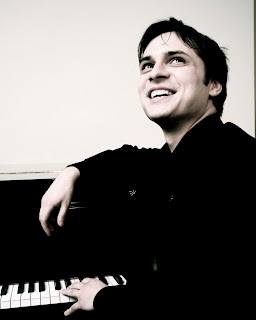
Sasha Grynyuk
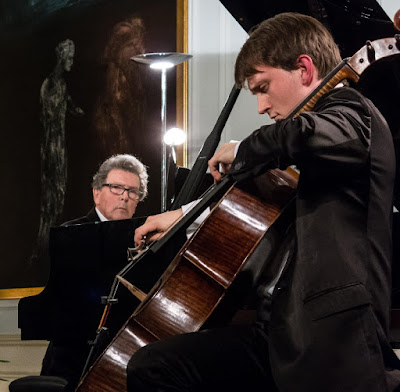
Howard Blake and Benedict Kloeckner performing together in 2012
Howard Blake remains best known for his music for the animated film The Snowman, with the song Walking in the air remaining inextricably linked with the composer's name. But his career has been far wider and varied than this, encompassing film music including Ridley Scott's The Duellists as well as a substantial body of concert music. But if you only know Blake from The Snowman and the film music, his concert music can be something of a surprise. Tonal and approachable in a tradition that links Blake to his original composition teacher at the Royal Academy of Music, Howard Ferguson, Blake writes large scale pieces of great depth and complexity. (Read my interview with Howard Blake). |
| 14th May 2017 | Eveleyn Hilschmann,Muttertagskonzerte Der Philharmonie am Forum, with Rolf Schllli, Reithalle,Musikschule in Offenburg, Germany
Dienstag, den 2. Mai 2017 um 12 Uhr in den Raum 130 der Musikschule in Offenburg.Wir möchten Ihnen das Programm und die Highlights des kommenden Muttertagskonzerts der Philharmonie am Forum vorstellen (14.5.17, Reithalle). Teilnehmen werden Rolf Schilli, Leiter der Philharmonie am Forum, sowie die Solistin Evelyn Hilschmann. |
| 18th March 2017 - 19th March 2017 |
Evelyn Hilschmann (piano),Nikolaus Indlekofer (cond.) KIT Philharmonic Orchestra, |
| 18th March 2017 - 1st July 2017 |
18 March 2017 Karlsruhe: Evelyn Hilschmann (piano),Nikolaus Indlekofer (cond.) KIT Philharmonic 14th May 2017 Offenburg tbc ; Evelyn Hilschmann (piano), Rolf Schilli(cond.) Philharmonie am Forum May/June 2017 Dusseldorf tbc : Constantin von Knebel Doeberitz (piano) details tba, |
| 27th December 2008 | Nadia Giliova, Murmansk Philharmonic Orchestra conducted by Alan Cook, Murmansk, Russia
Russian premiere |
| 3rd November 2008 | Nadia Giliova solo piano, Tobias van de Locht conductor, Sinfonia of Dusseldorf, big band of Clara Schumann Academy etc, Savoy Theatre, Dusseldorf, Germany, 8.00pm
As part of an all-Howard Blake festival birthday programme including Symphony in one movement, The Duellists, The Riddle of the Sands, Heartbeat, Suite from Flash Gordon, The Bear (new German translation) etc |
| 28th October 2008 | William Chen, solo piano, with The Royal Philharmonic Orchestra conducted by Howard Blake, The Cadogan Hall, Kensington, London
The Royal Philharmonic Orchestra scheduled a major concert of Howard Blake's music as part of their Cadogan Hall Season to celebrate his 70th birthday on October 28th 2008. The programme was conducted by the composer and included the concert version of 'The Snowman' for treble (sung by the 10-year old Robert William Blake), narrator (Nigel Havers) and orchestra; The Piano Concerto (originally commissioned for the 30th birthday of Princess Diana) played by William Chen, the brilliant Shanghai-based pianist who so memorably recorded Howard Blake's monumental work 'Lifecycle', and the London premiere of 'The Passion of Mary', a major new work for soloists, choir and orchestra, featuring soprano Patricia Rozario, tenor Martyn Hill, Swedish bass Lars Avidson and the chamber choir of London Voices directed by Terry Edwards. |
| 8th August 1992 | Howard Blake (piano), Anthony Inglis (conductor), RPO, Kenwood Lakeside |
| February 1992 | Brighton Philharmonic Orchestra conducted by Howard Blake. The Piano Concerto played by the composer, conducted by the leader of the orchestra,, The Dome Concert Hall, Brighton
The concert was all-Howard Blake programme presented by his home city, Brighton, in the presence of the Mayor and other dignitaries. Programme: 1. Concert Dances for orchestra. 2. The Snowman concert version for narrator, boy soprano (here sung by Brighton Childrens Chorus), and orchestra; 3. 'The Bells', a cantata for massed children's chorus and full orchestra, a setting of Edgar Allan Poe's 'The Bells' (commissioned by The Brighton Philharmonic Society and Sussex Arts); 4. The Piano Concerto. |
| 19th June 1991 | Howard Blake (piano) with The Philharmonia Orchestra conducted by Carl Davis., In the presence of HRH Diana The Princess of Wales at The Royal Festival Hall. |
Reviews
Worthing Symphony Orchestra “Walking In The Air” concert at Assembly Hall, Friday 31 January 2020 (7.30pm), composer Howard Blake (narrator), John Alley (piano), Victoria Ridgway (singer) John Gibbons BEM (conductor), Julian Trevelyan (concerto piano).
Nik Rimsky-Korsakov, Dance of The Tumblers (from The Snow Maiden); Fred Delius, Sleigh Ride; Emil Waldteufel, Skaters Waltz; Howard Blake, The Snowman, concert version; Pete Tchaikovsky, Waltz (from Swan Lake); Leroy Anderson, Sleigh Ride; Johnny Sibelius, March (from Karelia Suite); Howard Blake, Piano Concerto Opus 412.
It was as though Sergei Prokofiev had been right there, narrating his own Peter And The Wolf with Worthing Symphony Orchestra. To audience surprise, Howard Blake was doing the same in The Snowman – a children’s composition of parallel universal success composed by he, an ex-Brighton & Hove Grammar School boy, and with some primary and secondary classmates in the audience.
Unbilled except last-minute on social media, Blake told me he was narrating a Snowman concert performance for the first time in five years. He was standing in for also-unpublicised actor Bernard Cribbins OBE, whose wife was unwell. Wombles voice-over Cribbins reached 91 in December. A month earlier, Blake OBE made it to 81, although he scarcely moves or looks older than 70. That’s the therapy of music for you.
Blake’s own ‘local lad makes good’ story happened 40 years ago when his idea of a TV cartoon outlawing dialogue struck gold. Instead, it’s musically with descriptive richness and synchronised with the precision of a Tchaikovsky-Petipa ballet, and delivering a hit song that seasonally sits alongside Irving Berlin’s White Christmas.
The familiar I’m Walking In The Air – the only words heard in the cartoon film – is sung by the Boy when the Snowman he has built suddenly lifts him up into flight, out over Brighton and up to the North Pole for a knees-up at a snowmen’s party visited by Father Christmas. A thaw-surviving scarf from that is living proof it happened for real, trumping at Christmas the Nutcracker Doll that can only underline a dream.
Now it was happening right here, without the images but with author Raymond Briggs’ dialogue pointed up by Blake’s music. A different and rewarding audience experience this way round. And a master class in light film music orchestration . . .
Sleep? Harp or strings. Fun building a snowman? Fairy harp and chirpy flute. Snowman greets his young creator? Cheery piccolo. Atmosphere around the boy’s house? Sober, nostalgic oboe. Terrified fleeing cat? Screeching strings. Snowman curious about human life? Cheeky bassoon or avuncular horn.
Perilous sources of heat? Cymbals! (Furtive footsteps? Xylophone) Music box? Glittery harp, piano, flute, piccolo. Motor-bike escapade? Tearing orchestra with xylophone saddled on top! The Celidh of the Father Christmases? Celtic pub dance tunes on flutes, piccolo, xylophone, muted trumpet.
And binding much together, the piano – setting new scenes, initiating rhythm and texture, creating mystery, punctuating or decorating percussively, bringing sentiment and affection, opening the mood and flow of I’m Walking In The Air for vocalist Victoria Ridgway – from Crawley, invited from the West Sussex Youth Choir.
The 17-year-old was singing it publicly for the first time and her nerves in the opening verse counted in her artistic favour. Initially frayed-edged in childlike wonder and fear (“What? My snowman’s really a bird?”), her voice gained in confidence (“He’s not going to drop me now – I’m flying too!”) arriving at a purity (“This is the best adventure I’ve EVER had”).
Incidentally, the washes of cymbals evoked for me the Cornish beach hut where Blake, years before, first thought of this tune. Blake’s is an unfamiliar face to most. His narration was thus like listening to a story a nice granddad at a small (under-control) children’s birthday party up the road. Throughout The Snowman, I sensed the audience’s adults captured by their own fascination and progressively moved. The final ovation’s vocal element was heartfelt.
Blake brought also his own Piano Concerto and soloist, the 21-year-old Paris-trained Briton, Julian Trevelyan. It’s rarely played, despite its distinctive, pleasing and constantly entertaining vigour and melodic content, easy form and good humour, since its commission for Princess Diana’s 30th birthday 29 years ago. Blake performed it for her at the Royal Festival Hall. Surely, her death is not the reason for its back seat in Blake’s output? “Yes, it is a portrait of her,” he replied. “There’s her warmth and sense of fun.”
After a shyly radiant opening musical vision, it garrulously flecks in syncopations and cross-rhythms of popular musical styles – though less prominently than in for example Ravel’s two-handed Concerto. Imagine a lively garden party, getting going. But in the jubilant, cosmopolitan finale of theme and variations they shine brightly and integral to the effervescence which, at the end, unexpectedly but poetically leaves us with a bookending repeat of that halting opening camera shot.
There are one or two royal sweeps of cinematic strings and French Horn grandeur, and the tenor trombone pair join in the contrapuntal fun.
The middle movement, far less loquacious, paints its own intimate photo or character album.
It began and ended with just piano plus the leaders of the three violin and viola section leaders, whom at rehearsal Blake persuaded Gibbons and the players themselves that they should stand to play. The effect in performance was of something original being done spontaneously as an apt focus on music speaking of loving homage and respect. A remarkable concert moment and result.
Trevelyan was bristlingly alive, alert and responsive to the Concerto’s solo demands and range, and evidently attuned with a composer whose birthday precedes his by a day. It was Trevelyan’s second performance of a piece composed for Russian prodigy Evgeny Kissin – who reportedly backed out of the premier, finding it too demanding to prepare in apparently ample time. It took Blake three months to prepare in Kissin’s place because Blake had abandoned concert piano performing.
But it took Trevelyan just a month before his December debut in it. “It’s challenging with its use of non-classical rhythms being put in a classical context,” he told me. “The trick is to let it sing, and to make an interpretation without destroying its simplicity.”
This climaxed and closed the concert, and won another enthusiastic reception. Trevelyan brought Blake on stage for a hug and then won over the audience without him in Chopin’s Mazurka No 2 in D major of Opus 33 as an encore.
What of the rest of the programme? Far from makeweights or fillers, they were Gibbons with reindeer bells setting a winter’s scene around a snowman. Rimsky’s bounding dance of the Russian street performers laid out cold any preference for a conventional overture. Delius’ Sleigh Ride and wander off on foot around snow-laden countryside may well have been a WSO first.
A Skater’s Waltz by a Strasbourg-born composer could not escape the notice of politically-aware Gibbons on Brexit Day. Out on Anderson’s stateside Sleigh Ride, the WSO were fully on the ball with its finger-snapping wit, and the Karelia Suite finale marched in out of the tundra chill with a genuine glow.
But seizing the biscuit was the one item which could have passed by unnoticed in a routine rendition – but instead launched the second half with hum-along anticipation. Gibbons and WSO gave us a Swan Lake Waltz with astute variation in dynamics and a sweeping conclusion of festive Russian theatricality lacking only Bolshoic vibrato in Tim Hawes’ important trumpet solo. Do take us the whole way to Moscow next time, Tim!
Richard Amey
Richard Amey, Shoreham Herald, 6/2/2020
Bold romanticism: Howard Blake's Piano Concerto and Diversions
Howard Blake Sleewalking, Piano Concerto, Diversions, Elegia Stravagante; Sophie Witte, Sasha Grynuk, Benedict Kloeckner, Nicolas Dautricourt, Royal Philharmonic Orchestra, Howard Blake; Cadogan Hall - Reviewed by Robert Hugill on Sep 7 2017
Howard Blake's piano concerto at the centre of an evening of his complex, and dramatic concertante works
The Royal Philharmonic Orchestra opened its 2017/18 season with a programme of music by Howard Blake, conducted by the composer. The centrepiece of the programme was Blake's Piano Concerto, originally commissioned by the Philharmonia Orchestra to celebrate the 30th birthday of Diana, Princess of Wales in 1991. Blake himself performed the taxing piano part at the premiere, this time he conducted with Sasha Grynyuk at the piano. Cellist Benedict Kloeckner was the soloist in Blake's Diversions for cello and orchestra (a work originally written for Maurice Gendron), and Kloeckner was joined by violinist Nicolas Dautricourt to give the premiere of Blake's Elegia Stravagante (Duo Concertante) for violin, cello and orchestra. The evening opened with a new version of Blake's Sleepwalking for soprano and string orchestra, with soprano Sophie Witte
Howard Blake remains best known for his music for the animated film The Snowman, with the song Walking in the air remaining inextricably linked with the composer's name. But his career has been far wider and varied than this, encompassing film music including Ridley Scott's The Duellists as well as a substantial body of concert music. But if you only know Blake from The Snowman and the film music, his concert music can be something of a surprise. Tonal and approachable in a tradition that links Blake to his original composition teacher at the Royal Academy of Music, Howard Ferguson, Blake writes large scale pieces of great depth and complexity. (Read my interview with Howard Blake).
Sleepwalking was originally written as a companion piece to Villa Lobos' Bachianas Brasileiras No. 5, for the same forces soprano and eight cellos. In his programme note Blake talked about finding the idea of eight cellos conjuring up the world of dreams, and his piece posits a scenario of a young woman asleep who then goes sleepwalking through various traumas before returning to sleep. Starting from atmospheric high sustained strings with the soprano vocalise over the top (the whole piece is wordless) the piece moved through seven highly contrasting movements, finally returning to the tranquillo of the opening. We had a series of highly varied moods evoked by instrumental writing very much in the English tradition of string music, from lyrical through to darker dramatic episodes. Witte sang with a lovely even tone, and a beautiful freedom at the top. A well put-together piece which did not quite take me on the journey the composer intended, and I would be interested to hear the original version.
Howard Blake's Piano Concerto is a large-scale dramatic work. It was in some ways the most conventional work in the programme, in three movements (the others were in seven or eight) and the only one to use classical sonata form. Christopher Palmer's 1991 programme note used the term Mozartian, but the composers who came to mind were Rachmaninov and Tippett; Rachmaninov for the big boned romanticism piece, particularly the piano writing, whilst Tippett for the way the piano texture sometimes eschewed showy bravura (but not complexity) and created a continuous texture which flowed over the orchestra..
The first movement started with an understated ear-worm on the piano alone, which Blake then developed into something more dramatic with tutti. Sasha Grynyuk was tireless, and indeed the piano solo got little rest in this movement. Even the cadenza eschewed virtuosity and was rather thoughtful and, unusually, ended the movement. The second movement started with solo piano chords accompanying solo violins and viola, until the tables were turned. The melodic piano line wandered expressively, but always with an elegant simplicity, and finally the whole ensemble moved the temperature up a notch and we got something richly romantic. The final movement started with a perky piano toccata, and developed into a series of variations with hints of jazz/blues. Often highly vigorous, the jaunty melody passed round the orchestra, but always with the piano to the fore over the top. Towards the end we had a simple return to the main theme in the piano before the big finish.
Blake's Piano Concerto is a terrific work, I enjoyed his recording of it (see my review) and I enjoyed this performance immensely. Sasha Grynyuk brought out the poetry in Blake's writing, and played the part with great flair. With longer rehearsal time, there would have been chance to iron out some of the issues of balance, Grynyuk's approach concentrated on poetry and nuance rather than sheer power, but overall he and the orchestra brought it off brilliantly and I hope it makes other orchestras interested.
After the interval the German cellist Benedict Kloeckner played Blake's Diversions. Originally written for Maurice Gendron (who encouraged Blake to add a cadenza and generally make the piece more virtuosic), the premiere was given by Steven Isserlis in 1989. But then it slept somewhat until Kloeckner played the version for cello and piano in the semi-finals of the European Broadcasting Union Awards in Bratislava (and went on to win the competition). Subsequently Kloeckner had played the work a number of times with Blake accompanying on the piano. But for this concert we heard the original orchestral version. It is based on an instrumental dance suite, with eight movements encompassing scherzo, march, waltz, aria serenade and sarabande, though in each Blake develops things in interesting ways. We started with Kloeckner's cello singing over an intense rather dark orchestral accompaniment. The scherzo was full of character, and toccata-lie, whilst the march developed into a really big romantic solo for the cello (and Kloeckner really made the piece sing here). The waltz was wistful and rather sly, with the cello line weaving in and out of the orchestra, and the serenade had the solo duetting with the oboe before moving into the perky sarabande which developed into a cadenza which had orchestral comments (including not quite raspberries from the bassoons). The finale was fast and furious, and completely joyous. Kloeckner clearly loves this work, and the virtuosity of the piece seems to suit him, he made everything magically engaging.
The final work in the programme was a new piece, Elegia Stravagante (Duo Concertante) for violin (Nicolas Dautricourt) and cello (Benedict Kloeckner). In seven movements, it started with violin and cello alone playing a melodic motif that sounded suspiciously like noodling, but in fact proved a fertile source for the musical inspiration of the piece. For much of the piece, the two soloists play together (in unison in some movements), and the effect was more like the structure of a baroque concerto rather than the large-scale battle of a full blown Romantic concerto.
During the work's seven movements, Blake brings back the original motif repeated in vastly different guises, creating some intense and full blown romantic moments, interspersed with episodes using different material such as a 'jazz fugue'. The two soloists often soared in unison (at one point at a 16th) over the orchestra, and the was a notably intense solo moment for Benedict Kloeckner, whilst a rather threatening orchestral passage rather evoked Walton. For the ending, there was a sense of the piece gradually unwinding, a moment for violin solo turned into a duet with the cello and the piece ended with just the two of them returning to the original motif.
This was a long and substantial concert, full of dramatic and complex music. It was a great pleasure to finally hear Blake's Piano Concerto live, as well as to experience the full orchestral colours in Diversions. Throughout Blake was supported by the sterling players of the Royal Philharmonic Orchestra, playing nearly two hours of complex and unfamiliar music, whilst the soloists encompassed the taxing demands of the solo parts in brilliant fashion.
Of course, no Howard Blake concert would be complete without The Snowman and as an encore Dautricourt and Kloeckner joined Blake and the orchestra for a version of Walking in the Air specially created for the occasion
Robert Hugill, Planet Hugill, 7/9/2017
Howard Blake's Concerto for Piano and Orchestra was commissioned by the Philharmonia Orchestra in 1991 to celebrate the 30th birthday of Diana, Princess of Wales. It was given its premiere by the orchestra, conducted by David Willcocks, with the composer playing the piano part. The work had been recorded by Sony prior to this performance and this recording was reissued by Sony in 2008.
It is a substantial work lasting over 26 minutes and cast, as you might expect from Blake, in traditional form. Blake's career as a composer has been spent mediating between the traditional and more contemporary elements in the 20th century classical style.
The opening movement starts with an evocative and wistful Lento, a movement to which you might give the adjective filmic. Blake's concert music is fascinating for the way he does not turn his back on his film music but absorbs it and develops it. The music then gathers momentum, and the solo piano part become more strenuous as the Allegro bursts onto the scene. The writing is tonal, but complex and requires something from the listener. The piano writing is quite strenuous, but the soloist is rather part of the texture in the baroque or classical manner, rather then in combat with the orchestra in the Romantic tradition.
A hushed orchestra introduces a slow, evocative piano in the Andante espressivo. The movement develops with piano running passages through the orchestra texture, which culminates into a rather wonderful, big romantic moment The final Vivace wonderfully perky with the busy piano part loudly interrupted by the orchestra, and some lovely jazzy moments.
When I interviewed Howard Blake, he talked about how he had to re-learn his piano technique to play the piano part. The results are impressive and confidently fluent. It is piano writing which is probably difficult, but not always showy and Blake shows himself a sympathetic soloist, finely supported by Willcocks and the Philharmonia Orchestra.
The companion works to the concerto are two more of Blake's large scale orchestral works. His Diversions for Cello and Orchestra were written in their final form in 1985, with the cello part edited by the cellist Maurice Gendron. It started out life as a set of pieces for cello and piano, but the involvement of Gendron led to a considerable expansion of the piece with a commensurate increase in the virtuoso bravura of the solo cello part. Blake has recently started playing this bravura version with cello and piano and plans to record it with cellist ????
This recording of the orchestral version was made with Blake conducting the Philharmonia Orchestra, with cellist Robert Cohen as the soloist. The work is a sequence of relatively short movements which hark back to the suites of the past. The opening Prelude is melancholy, with the cello singing in the alto register at first unaccompanied and then with just high strings. A perkily busy not quite Scherzo leads to a melancholic, rather dramatic March. The rather busy Waltz has some rather skittish, skittery playing. The Aria is the longest movement, it is slow and dark, with a sense of sustained intensity. Serenade is a rhythmic and melodic dance, and here the solo cello part starts to get rather busy indeed. The Sarabande and Cadenza provides the solo cellist with some wonderful virtuoso display moments, with quite a spare and dark accompaniement from the orchestra. The Finale is fast and furious with a wonderfully bravura end.
Blake's Diversions is a terrific work which combines an element of bravura with just the right element of fun and Robert Cohen is suitably dazzling in the solo part.
The final work on the disc,Toccata (A celebration of the Orchestra) was commissioned by the Royal Philharmonic Orchestra for the 30th birthday season (1976/77). The version performed on the disc was revised by Blake in 1988/1990. The work is a large and complex piece designed to show of the orchestra, but allied to a quite sophisticated structural imagination. All based on an 84 bar theme, Blake plays imaginative games in the way he shows off the orchestra and demonstrates his ingenuity. The joy of the piece is that none of this really matters, as when you listen you are carried away. The first section of the work displays the various sections of the orchestra, with the music having a quiet sense of steady overall progression. Blake uses a lively imagination in the way he gives each section of its orchestra its moment. And then the piece concludes with a wonderful jazzy fugue.
None of the works on this disc is well known, and the disc itself is slightly tricky to obtain. But I rather like Blake's imaginative re-working of contemporary style. The music here doesn't seek to re-define or push boundaries, instead it builds intelligently what has gone before. The results are neither simple nor simplistic and fascinating in their combination of wit and complexity.
Elsewhere on this blog:
Robert Hugill, Planet Hugill, 16/8/2014
A concerto which would be agreeable in any programme ... elegant, with enough salt in the orchestral mixture to give it flavour. It is good to find a composer looking to the Ravel Piano Concerto as a model ... The neo-classical chatterings in the piano-writing directly echo that model, together with the jazzy syncopations of the outer movements, which in turn pay a debt to Gershwin.
Edward Greenfield, The Guardian, 3/1991
TRIPLE DEBUT - An Appreciation by Christopher Palmer
Popular music – that is, music for the people – is very difficult in almost every way: difficult to write (well), to perform (well), to record, to market. Most of all it is difficult for “serious” musicians and critics to come to terms with. Their difficulty with popular music lies ironically in the one way in which, per se, it is not difficult at all: namely to appreciate, to listen to, to enjoy. The English seem always to have had a problem with enjoyment. They tend to be suspicious of, even dismissive of, anything, which makes too strong or direct an appeal to the senses and fails to engage the intellect. Consequently the dividing line between popular and serious music – or if you like between pop and art – has always been more rigidly defined here than in America, where they had Leonard Bernstein to demonstrate that one could be lecturing at Harvard one day and rehearsing a Broadway musical the next. Things are somewhat better now – largely due to the pioneering efforts of André Previn and others – but still bad enough to ensure that people like Howard Blake have had a hard time gaining not so much popular as critical acceptance.
In reality we are witnessing a manifestation of a much more basic conflict, one which besets civilized man in proportion as his lever of sophistication evolves through civilization – namely the relationship between innocence and experience. Howard Blake had a distinguished namesake – the poet William Blake – who gave a lot of thought to this matter.
There are in fact a number of affinities between the Blakes, not least the insistence of “firm strokes and clear outlines” which WB learned from his mentor, the engraver James Basire, and which has always characterised the music of HB. WB thought of ‘innocence’ as synonymous with that free creative energy which is the channel of man’s communion with God; not so much the state of childhood itself as the conditions which the idea, or ideals, of childhood invoke, the most important of which is the ability to accept life in all its aspects as a source of joy. Excessive materialism, mechanistic rationalism and intellectualism – by whom and in whatever form they are promoted – tend to restrain that energy and thence deny the spiritual significance of life. WB’s recurring theme is that of a world gone wrong because man has misused his natural endowments.
Many of Benjamin Britten’s greatest works conduct an anguished dialogue between the antitheses of innocence and experience. No composer felt more weighed down by the curse of consciousness, the disease of feeling, the ‘mind-forg’d manacles’. For HB, however these fetters seem either never to have existed or to have been silently unlocked. Like the happy picnic crowd in Gershwin’s Porgy and Bess (the work, incidentally, of another of music’s Heavenly Babes), ‘he ain’t got no shame/Doing what he likes to do’.
It is surely no accident that Howard Blake still has the demeanour, the outlook, event the appearance, of someone half his age. He has a first-rate sense of humour – by which I do not mean merely a sense of fun (he is an outrageous mimic, particularly of pompous after-dinner speakers or lecturers or bores encountered at parties) but, more importantly, the ability to see himself and his work in a realistic perspective. This is what has saved him from becoming a victim of his own remarkable facility. Multi-talented people – in music, as in other things – often fail, ultimately, through not knowing what to focus on. Howard’s will to survive, to achieve has helped him overcome this. Growing up in Brighton, he played the organ as a boy and sang lead soprano roles in Gilbert & Sullivan and other operettas: facts which may account (a) for the expertise of his choral writing in his major choral work, Benedictus and (b) for his special understanding of children’s voices, as demonstrated in The Snowman and Granpa.
Howard was originally destined to go to Oxford but instead won at 18 a scholarship to the Royal Academy of Music. Here he studied piano with Harold Craxton (even more impressive than his piano technique is his ability to play large chunks of piano and orchestral repertoire from memory at the keyboard) and composition with Howard Ferguson.
Already music of his was being published and performed while he himself was giving concerts of chamber music. He developed a passion for the cinema and, in fact, first earned his living for two and a half years as a projectionist at the National Film Theatre. During this time he made a film of his own and early acquired a taste for doing everything himself; today he always likes to be involved with as many aspects of his projects as he can. Jazz was another interest which developed in his immediate post-student days, and for a while he played piano in clubs. Thence he gravitated to playing as a session musician, and this took him into the world of records, radio, films and TV. Here he met fine musicians like Laurie Johnson and Bernard Herrmann, and it was Laurie who in 1968-9 invited Howard to compose some episodes of the‘Avengers’ TV series. This led to many other commissions for feature films, documentaries, shorts and commercials for TV and the cinema.
Of course composers, like other people, have to earn a living once their training is completed and, from the 1920s on, many such professionally trained composers – I do not speak here of those from other backgrounds like the theatre and popular music – have welcomed the opportunity to write for the media. One of two things generally happens to these composers: either they give up composing their ‘own’ music altogether, or – more often – the one career runs parallel to the other.
This, after all, is only to be expected if the composer is a ‘real’ one. What is almost unheard of is for a composer deliberately to abandon a flourishing career in media-music, in midcourse, in order to devote himself exclusively to his ‘own’ or ‘real’ music. Yet that is precisely what Howard Blake went on to do. In the early 1970s he weighed what he’d achieved in the balance, and found it conspicuously wanting (except in economic terms).
He decided to start from scratch again; a turning-point, a milestone on the way to the composer (i.e. the person he has now become). He left London, took up yoga and meditation, sat on a beach in Cornwall, bought a millhouse in Sussex, took up gardening. He also practised classical piano, did counterpoint exercises, and composed abstract, non-commercial music; the Piano Quartet, the Diversions for cello, the Violin Sonata, various songs, the Dances for Two Pianos and Toccata for Orchestra. Gradually the media came back into his creative life but on a new footing. Ballet became a major interest; Sadler’s Wells, the London Contemporary Dance Theatre and TV commissioned scores. In 1978, while living in Sussex, Howard had written a cantata, The Song of St Francis for the nearby Benedictine monastery, Worth Abbey.
Alongside film scores such as The Duellists, Agatha and The Riddle of the Sands, there grew up a large-scale choral piece, Benedictus. First performed in 1980 and later both publicly performed and recorded for CBS/Sony by Sir David Willcocks and the Bach Choir, it is a work by which Howard sets great store since, in a sense, it reflects his own spiritual odyssey. He has rejected the blandishments of commercialism the interests of becoming a better composer and, therefore, making a more valuable contribution to society.
CONCERTO FOR PIANO AND ORCHESTRA
Commissioned by The Philharmonia to celebrate the birthday of Diana, Princess of Wales
This, Howard Blake’s most recent large-scale work and his only major composition for piano to date, was commissioned by The Philharmonia in honour of The Princess of Wales’ 30th Birthday. It has a deceptive simplicity not unlike that of Mozart. I mention Mozart advisedly since the classical qualities implicit in scores like The Snowman and Diversions are on full frontal display in the Piano Concerto. There is a childlike exuberance and spirit of delight. The work was written at a time of great personal happiness and the music reflects this; but a shrewd supervisory intelligence plots every move and never allows the plain, ordinary, even commonplace musical language it speaks ever to sound plain, ordinary or commonplace. Much of this is due to a strong feeling for line, and not just melody: counterpoint is far more of the essence of Blake’s music than harmony. To cast a full-scale concert work in a simple diatonic style with no sense of déjà entendu is, in the 20th century, a considerable achievement.
The first movement is in more or less regular sonata form, the distinctive profile of both first and second subjects being drawn by the solo piano in the opening bars. An attractive (Mozartian) feature – in fact once of the loveliest passages in the work – is the introduction of a tranquil new theme, a new episode (clarinet solo, then bassoon) at the height of the development, before the climactic lead-back to the recapitulation. The cadenza – really more of an extended piano solo, senza bravura – is placed at the very end of the moment.
The second movement is a song-without-words or instrumental aria, whose roots probably lie in the popular ballad-style of the 1960’s, a style admired by Blake for its new harmonic simplicity and unsentimental melodic expressiveness.
The third movement takes the form of a theme (announced by the solo piano giocoso after a 42-bar-long introduction) and six variations, which include a brillante display-piece for violins (No.4), a fughetta for solo brass instruments (No.5) and a sudden dazzling, rainbow-arch in E major – there is something magical, transfiguring even, about this key – with the theme intentionally buried in the cellos. After that the music gathers momentum for an uninhibited coda.
The Concerto was composed in the summer and autumn of 1990 and was first heard in December of that year, when this recording was made. Its world premiere public performance took place on May 19, 1991, the day preceding the release of the album.
© 1991 Christopher Palmer
Christopher Palmer, Sony CD booklet 1991 and 2008 re-release, 2/1991
..it has a deceptive simplicity not unlike that of Mozart. I mention Mozart advisedly since the classical qualities implicit in scores like 'The Snowman' and 'Diversions for cello and orchestra' are on full frontal display in the Piano Concerto. There is a child-like exuberance and spirit of delight...but a shrewd supervisory intelligence plots every move and never allows the plain, ordinary even commonplace musical language tit speaks ever to sound plain, ordinary or commonplace. Much of this is due to a strong feeling for line, and not just melody: counterpoint is far more of the essence of Blake's music than harmony. To cast a full-scale concert work in a simple diatonic styel with no sense of deja entendu is, in the 20th century, a considerable achievement.
Christopher Palmer, The Philharmonia Collins Classics Series, 1991
An attractive addition to the surprisingly limited list of modern British piano concertos.
Edward Greenfield, Penguin Guide to Compact Discs & Cassettes,

